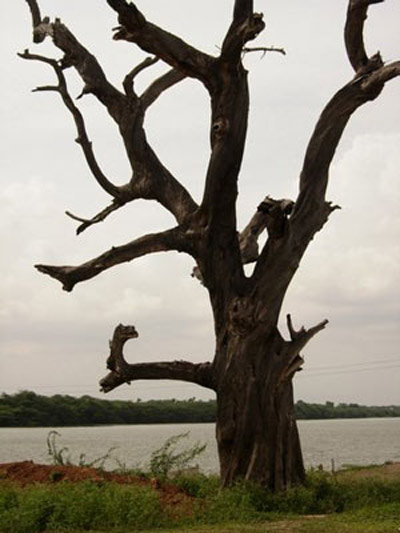Bhima River
Bhima River |
About: |
|
Bhima River originates in Bhimashankar hills near Karjat on the western side of Western Ghats, known as Sahyadri, in Maharashtra state in India. Bhima flows southeast for 725 km through Maharashtra, Karnataka, Andhra Pradesh states. Bhima is the most important tributary of the Krishna river, which is one of the two majors rivers in Maharastra, the other being Godavari River. Nira confluences with Bhima in Narsingpur, Solapur. Bhima is a major tributary of the Krishna River. Its banks are densely populated and form a fertile agricultural area.The river is prone to flooding due to heavy rainfall during the monsoon season. Rising in the western ghats to the east of Mumbai, the Bhima River is one of the major confluents of the Krishna River. The river rises from the Bhimashankar hills near Karjat on the western side of the Western Ghats at an altitude of about 945 m above the sea level. It is known as Sahyadri in Maharashtra. The Bhima River flows in the southeast direction for seven hundred and twenty five kilometers covering the states of Maharastra, Karnataka and Andhra Pradesh. In the course of the journey it meets many small rivers. The major tributaries of this river around Pune are Kundali River, Ghod River, Bhama River, Indrayani River, Mula River, Mutha River and Pawana River. The Indrayani, Mula, Mutha and Pawana flow through Pune and Pimpri Chinchwad city. The major tributaries of Bhima in Solapur are Chandani, Kamini, Moshi, Bori, Sina, Man, Bhogwati and Nira. The Bhima meets the Nira River in Narsinghpur in Malshiras taluka in Solapur district. The last 298 km of its course is in Karnataka where it merges with the Krishna River near Kudlu in Raichur District. |
Location info: |
| Address: Bhimashankar hills,western side of Western Ghats,Maharashtra,India. |
| District: Ahmednagar District. |
| Nearest City: Pune. |
| Best time to visit: Any time,avoid monsoon seasons. |
Climate/Weather: |
| Summers-It reaches upto 44 c,Winters-Reaches down to 10 c. |
History: |
|
In this temple, Lord Eshwara is shown in Half man and Half woman (Ardha Narishwara) form.Bhimashankar, one of the twelve Jyotirlingas is at a distance of around 200kms from Mumbai. It is also the source of the River Bhima, which flows southeast and merges with the river Krishna. It is built in the Nagara style of architecture and dates back to the 18th century. One can also find influences from the Indo Aryan style of architecture. It is believed that the ancient shrine was erected over a Swayambhu Linga or a Self Emanated Shiva Linga. Thus the Linga is exactly in the centre of the floor of the Garbagriha or the Sanctum. Intricate carvings adorn the pillars and the doorframes of the temple. Within the temple precincts there is also a small shrine dedicated to Lord Shani.
|
Interesting things to do: |
|
Offer prayers to the deity, trekking, hiking, bathing in the river, visit to the nearby tourist attractions. Shopping in Bhimashankar: |
Interesting things to Visit: |
|
Bhimashankar temple: Shani temple: Mokshakund thirtha: Kamalaja: Bhimashankar Wild Life Sanctuary: Nagfani: |
Mobile range info: |
How to reach? |
| Nearest Railway Station:Pune |
| Nearest Airport:Pune. |
| Road Transport: Only bus transport is available to Bhimshankar from Pune. Central bus stand is nearer to railway station. Buses to Bhimshankar are run from Shivaji Nagar bus stand in Pune. This Bus stand is about 2Kms from Central bus stand. City buses are available to reach Shivaji Nagar bus stand. Auto richshaw facility is also available. Bhimshankar is 125Kms from Pune via Manchar. Manchar is 57Kms from Pune on National Highway 50. The first bus starts at 5.15am from Pune to Bhimashankar. |
Nearest Visiting places: |
| Some more places of interest here are, origin of Bhima river, Bombay point and Hanuman temple. In Pune city, Kelkar museum, Goddess Parvati temple are important. Nearer to this city, Mahabaleshwar, Kolhapur can be visited. Shri Mahalaxmi temple is very famous in Kolhapur. This temple is considered as one of the Shakti peetha. |
Nearest Petrol Pump: |
Hotels/Lodge/Accommodation: |
| There are many hotels and guest houses at the region that provide cheap accommodation to the guests. |
Things to carry: |
Tips & Suggestions: |
Help Line/Phone Number: |
| Police Station: 100 |
| Nearest Hospital: Lots of Govt. and Pvt. Hospitals are available in the nearby cities. |
| Society/Community Phone Number |

.jpg)
.jpg)
.jpg)
.jpg)
.jpg)
.jpg)
.jpg)
.jpg)
.jpg)
.jpg)
.jpg)
.jpg)
.jpg)
.jpg)
.jpg)
.jpg)
.jpg)
.jpg)
.jpg)
.jpg)
.jpg)
.jpg)
.jpg)
.jpg)
.jpg)
.jpg)
.jpg)
.jpg)
.jpg)
.jpg)
.jpg)
.jpg)